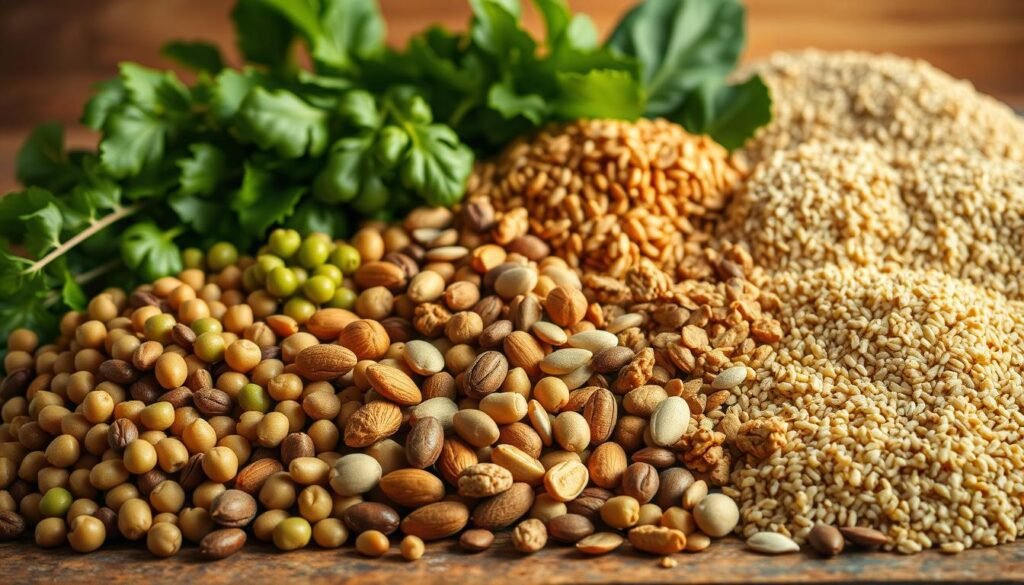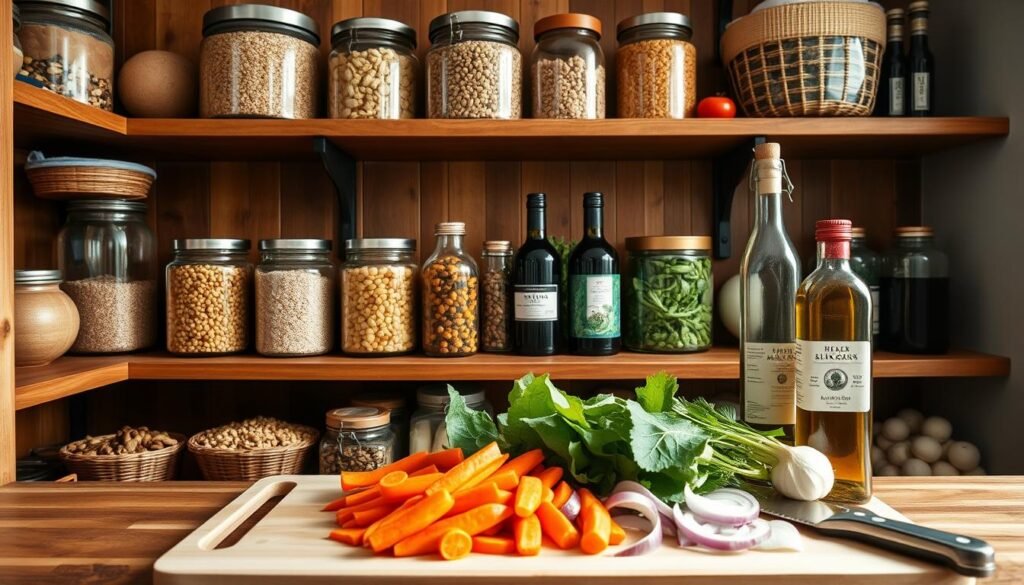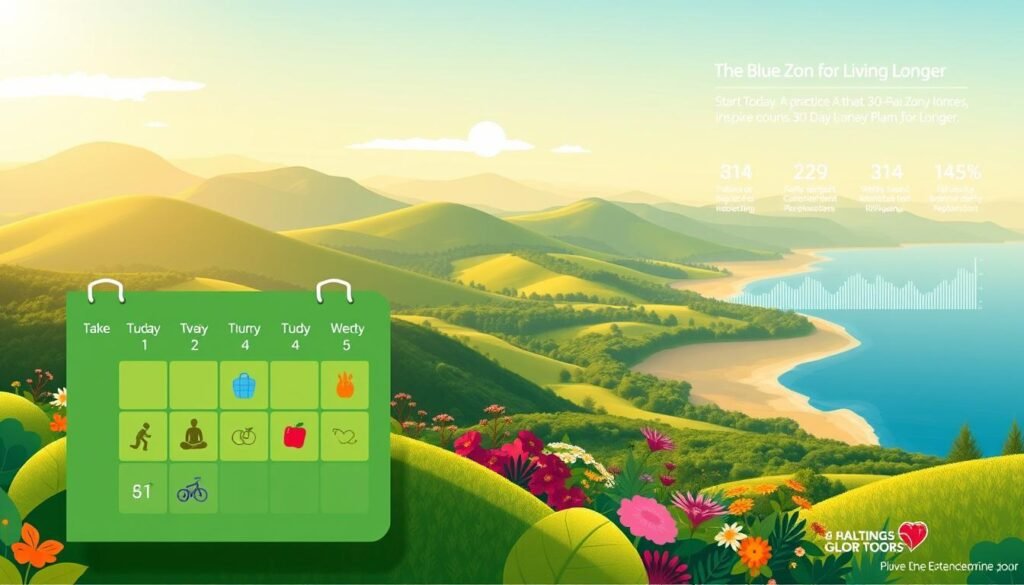Decoding the Blue Zones Diet: Secrets to a Longer, Healthier Life

This ultimate guide translates lessons from the blue zones into clear steps you can use at home.
Dan Buettner’s National Geographic work and community projects in Albert Lea and the Beach Cities show how simple policy and habit shifts raised life expectancy and cut smoking and obesity. These examples prove that designing daily life matters more than quick fixes.
In these places, people don’t chase trendy hacks. They set routines that support movement, social bonds, purpose, and a mostly plant-forward diet. Together, those patterns slow disease and help people enjoy more healthy years.
This guide blends storytelling and science. It draws on epidemiology, policy outcomes, nutrition research, and mental health resources from trusted sources so you get practical steps without hype.
Follow along for weekly meal frameworks, pantry swaps, movement ideas, and a 30-day plan that adapts globally but fits life in the United States.
Key Takeaways
- Practical steps: Convert blue zones habits into daily routines.
- Evidence-based: Uses community results and peer-reviewed research.
- Whole-person focus: Combines diet, stress reduction, and social ties.
- Actionable tools: Weekly menus, swaps, and a 30-day plan.
- Adaptable: Insights inspired by the world but tailored for U.S. life.
Why the Blue Zones Diet Is Trending in the United States
Popular shows and community pilots turned distant longevity examples into doable habits for many Americans. Media exposure made simple, repeatable routines—home cooking, walking, and shared meals—feel reachable rather than exotic.
What searchers want is clear: easy answers on what to eat, how to move, and how to reduce stress so they can add healthy years without extreme regimens. The guide that follows gives practical weekly plans and quick swaps that take little extra time.
Interest rose after Dan Buettner’s work and the Netflix series highlighted everyday practices from the world’s long-lived communities. That attention helped the concept travel from screens to neighborhoods when Blue Zones Project sites redesigned environments to support better choices in the united states.
Why people care: chronic conditions in the united states pushed demand for a sustainable way forward. The average american sees appeal in low-cost meals, walking, and social ties—habits that fit real life and limited time.
People also seek purpose and belonging, not just better health. Public health evidence and community results show small, consistent steps can reduce disease risk and add years, and interest now informs local policy, employer wellness, and kitchen-level change.
For stress and mental health context, see WHO’s mental health overview and the NIMH page on anxiety for practical resources that support downshift strategies.
Blue Zones 101: What They Are and Why They Matter
Epidemiologic evidence led researchers to specific communities where living past 90 is common. Those places are demographically confirmed areas where reaching milestones like 90 and 100 happens far more often than elsewhere.
Origins with National Geographic and Dan Buettner: Teams led by National Geographic researcher Dan Buettner combined birth records, fieldwork, and demographic analysis. Anthropologists, demographers, and epidemiologists traced patterns that pointed to five original regions.
Where people live to 100 at higher rates around the world
The five regions identified are Sardinia (Italy), Okinawa (Japan), Ikaria (Greece), Nicoya (Costa Rica), and Loma Linda (California, USA). Each area shows higher rates of centenarians and shared lifestyle traits later framed as the Power 9.
- Centenarians in these places reflect community norms, not rare outliers.
- Food, daily movement, social ties, and purpose shape day-to-day life and long life.
- Genetics play a role, but place-based factors often determine outcomes across people groups.
Why this matters: these documented communities show that environment and routine influence life more than willpower alone. The patterns discovered by Dan Buettner and his team provide a practical blueprint for rethinking habits and public policy in the United States.
The Science of Longevity: Lifestyle vs. Genetics
Research comparing twins shows the environment shapes most of our lifespan. The Danish Twin Study found roughly 20% of lifespan links to genetics and about 80% to lifestyle and place. That shift refocused researchers onto daily habits, policy, and community design.
What the Danish Twin Study taught us about lifespan
Key takeaway: genes matter, but routine matters more. Twin research pushed scientists to ask how movement, food, and social ties change years of healthy life.
Evidence base: epidemiology, peer-reviewed studies, and policy impacts
Population studies from the original blue zones and recent community projects show consistent patterns across people. Epidemiology links regular activity, a plant-forward diet, and social support to lower risk of chronic disease.
- Policy levers like walkable streets and better food access reduce obesity and smoking at a population level.
- Biological pathways under study include reduced inflammation, improved metabolic control, and telomere maintenance tied to stress reduction and diet (see peer-reviewed reviews).
- Mental health matters: unmanaged stress raises disease risk; downshifting routines help, per WHO and APA guidance.
| Factor | Typical Impact | Examples |
|---|---|---|
| Genetics | ~20% influence on lifespan | Danish Twin Study results |
| Lifestyle & Environment | ~80% influence on healthy years | Walkability, food access, social networks |
| Biological Mechanisms | Modulate disease risk and aging | Inflammation control, metabolic health, telomeres |
Bottom line: National Geographic helped popularize the story, but peer-reviewed data and public-health interventions back the claims. The evidence favors community strategies over lone willpower. Later sections show practical actions people of any age can use to add healthy years.
Power 9: The Core Lifestyle Patterns Behind Longevity
A set of nine simple habits—repeated daily—frames how many long-lived communities shape healthy years. These patterns act as a lifestyle architecture that fits into normal schedules and social life.
Move naturally
Everyday activity looks like gardening, walking to errands, and taking stairs. These choices keep muscles active without gym time.
Purpose
Ikigai or plan de vida gives people a reason to get up each day. That steady sense of purpose links to better resilience and longer, healthier life.
Downshift
Stress rituals matter. Short naps, prayer, gratitude, and mindfulness lower stress over time.
For practical methods, see guidance from the APA and Psychology Today on managing stress and mindfulness.
80% rule
Stop eating when nearly full—hara hachi bu—and favor lighter evening meals. Slower eating and simple timing reduce overeating and steady energy across the day.
Plant slant
Build plates around beans, whole grains, fruits, and vegetables. Small portions of meat appear rarely, and basic cooking keeps meals affordable and tasty.
Wine at five
If you drink, limit wine to small amounts with food and friends. Skip alcohol when it conflicts with medications or health goals.
Belong & Loved ones first
Faith groups, family meals, and multigenerational homes create accountability and care. Putting loved ones first makes healthy choices easier and more consistent.
Right tribe
Surround yourself with friends who model healthy habits. Social circles shape behavior and support change during hard times.
| Pattern | What it looks like | Practical tip |
|---|---|---|
| Move naturally | Gardening, walking, stairs | Choose active routes for errands |
| Purpose | Ikigai / plan de vida | Write one daily intention |
| Downshift | Naps, prayer, mindfulness | Set a 10-minute nightly ritual |
| 80% rule | Hara hachi bu, early light dinner | Pause mid-meal, drink water, then reassess |
Mainstream Nutrition, Reframed: The Blue Zones Diet Pillars
Everyday pantry staples in long-lived communities show how simple meals support steady health. Staples like beans, whole grains, leafy greens, and tubers form the base of most plates.
Whole grains, beans, greens, and tubers as everyday staples
Cook grains and beans in batches to save time. Use brown rice, barley, oats, lentils, and chickpeas for flexible meals.
Sweet potatoes and starchy tubers add fiber and slow-release energy—good for blood sugar control and satiety.
Olive oil, nuts, and seeds for heart-healthy fats
Olive oil and nuts provide monounsaturated fats that support the heart. Portion a tablespoon of oil per serving and a small handful of nuts to keep calories in check.
Fruits and vegetables in season, prepared simply
Buy seasonal produce for better flavor and value. Roast, sauté, or braise with minimal salt and herbs to keep meals quick and fresh.
Minimal meat and processed foods: how little is typical
Meat appears sparingly—about five small portions per month in many communities. Center plates on plants and add small animal servings when desired.
- Quick shopping list: whole grains, canned or dried beans, greens, tubers, olive oil, nuts, seeds, seasonal fruits and vegetables.
- Easy meals: bean stew, grain bowls with roasted vegetables, lentil soup, and simple salads with olive oil and nuts.
- Protein tips: combine grains + legumes for complete protein; include nuts and seeds regularly for variety.
- Pantry strategy: store dried beans, whole grains, canned tomatoes, and olive oil for fast weeknight cooking.
| Pillar | Typical Items | Portion / Frequency | Benefit |
|---|---|---|---|
| Whole grains & grains | Brown rice, barley, oats | Daily; batch-cook | Fiber, steady energy |
| Beans & legumes | Lentils, chickpeas, beans | Several times weekly | Protein, low glycemic load |
| Olive oil & nuts | Extra-virgin olive oil, almonds | Small amounts daily | Heart-healthy fats, satiety |
| Fruits vegetables | Seasonal produce, greens | Daily, varied | Vitamins, low-calorie volume |
How this supports diabetes-friendly eating: The plant-forward pattern emphasizes fiber and low-glycemic foods that align with CDC guidance on healthy eating. Combining grains and legumes boosts protein quality while keeping added sugars and ultra-processed items low.
Spotlight on the Five Original Blue Zones
Across five regions, ordinary routines and local foods shape remarkable patterns of health and community care. Each place shows how meals, movement, and social ties combine to support active, long lives.

Sardinia, Italy
Sardinia’s mountain shepherd life centers on hearty minestrone, legumes, and daily walking on steep trails. Community gatherings pair modest Cannonau wine with plant-forward plates.
Okinawa, Japan
Okinawa relies on sweet potatoes, frequent tofu dishes, and the practice of hara hachi bu—eating until 80% full. Close moai social groups protect mental and physical health.
Ikaria, Greece
Ikaria follows Mediterranean-style meals rich in vegetables and olive oil. Midday naps and low rates of dementia and heart disease mark daily life for many people.
Nicoya, Costa Rica
In Nicoya, staples are black beans, corn tortillas, tropical fruit, and mineral-rich water. A strong plan de vida keeps elders active and engaged in local routines.
Loma Linda, California
Loma Linda Adventists emphasize faith, mostly plant-based meals, and a weekly Sabbath downshift that supports recovery and purpose.
- Shared patterns: beans and vegetables sit at the center of most meals; meat appears rarely and in small portions.
- Community first: centenarians stay connected and useful through family and tight social networks.
- How to try it: adopt a minestrone, a sweet-potato stew, a Greek salad, a Nicoyan bean bowl, or a Sabbath-style family meal to bring these habits home.
Compare and adapt: each country expresses the same core principles—plant-forward cooking, natural movement, and strong ties—so readers in the United States can borrow simple dishes and build moai-like circles for shared cooking and walks.
Blue Zones Diet and Healthy Aging: What the Research Says
Epidemiology and lab work together suggest that whole-food patterns help preserve cellular health as people age. Reviews link plant-forward eating with lower all-cause mortality and fewer cardiovascular events and some cancers.
Telomeres and cellular aging
Telomeres are protective caps on chromosomes. Shorter telomeres associate with faster biological aging. Studies and reviews discuss how diet, stress reduction, and activity may help maintain telomere length over years (see PMC review and critical review).
Heart, cancer, and metabolic insights
Plant-rich patterns lower inflammation and oxidative stress. That translates to better blood glucose control, improved lipid profiles, and fewer heart events.
Evidence also links these patterns to reduced risk for certain cancers (AICR perspective). Together, these effects lower disease risk as people move through midlife and beyond.
- Synergy: diet, movement, sleep, and social ties work together to slow biological aging.
- Nutrient adequacy: varied plants, legumes, nuts, and grains cover most needs with mindful choices.
| Outcome | Mechanism | Practical takeaway |
|---|---|---|
| Cardiovascular risk | Lower inflammation, better lipids | Favor beans, whole grains, olive oil |
| Cancer risk | Reduced oxidative stress, fiber effects | Increase vegetables, limit ultra-processed foods |
| Metabolic health | Improved glycemic control | Choose fiber-rich meals and regular movement |
Bottom line: No single food guarantees more years, but consistent whole-food patterns align with broad health guidelines. Use these findings to start small, steady shifts; the next sections show practical templates to put research into daily practice.
Blue Zones Diet, Longevity Secrets
Everyday routines—small, repeated choices at home and in community life—add up to measurable extra healthy years.
Define the secret: it is not a pill or a fad. It is habits repeated for decades: plant-forward meals, steady movement, stress-downshifting, purpose, and tight social ties.
Food matters: plates centered on beans, whole grains, vegetables, and simple home cooking make healthy eating automatic. These patterns help people avoid processed options and stabilize energy across the day.
Non-food pillars are equal partners. Purpose, close friendships, and daily stress routines protect mental and physical health. Community design and small household nudges—like placing fruit on the counter or choosing stairs—reduce friction so good choices feel natural.
Why it works: the world’s longest-lived communities pair social cohesion with routines that compound. Success is consistency, not perfection. Small steps now lead to measurable gains over years.
| Practice | What it does | Easy start |
|---|---|---|
| Plant-forward meals | Lower disease risk, steady energy | Swap one meat meal/week for a bean stew |
| Daily movement | Maintains strength and metabolism | Walk 10 minutes after meals |
| Social & purpose | Buffers stress, encourages healthy habits | Join a weekly community meal or group |
Next steps: use the rest of this guide as a toolkit to translate these ideas into your daily way of living. Small, steady habits compound into real gains in life and health.
Protein on a Plant-Slant: Getting Enough the Blue Zones Way
You can hit protein targets without meat by combining legumes, tofu, and whole grains across the day.

Smart protein picks: beans, lentils, tofu, tempeh, nuts, seeds, and whole grains form the core. Modest fish appears in some regions, while meat stays rare and small.
How much protein most people need
For an average person, 0.8 g/kg body weight meets basic needs; active adults and older people often need more. Distribute protein across meals to aid muscle repair and satiety.
- Daily strategy: combine legumes + grains or add tofu/tempeh to reach targets.
- Practical swaps: bean chili for beef, lentil bolognese, tofu stir-fry, nut-seed salad toppers.
- Myth busting: plant proteins are complete when varied across the day—variety beats single-meal perfection.
| Item | Typical protein | When to use |
|---|---|---|
| Lentils / beans | 15–18 g per cooked cup | Soups, stews, bowls |
| Tofu / tempeh | 10–20 g per serving | Stir-fries, salads, sandwiches |
| Nuts & seeds | 4–8 g per small handful | Toppings, snacks, dressings |
Budget tip: batch-cook dried beans and grains. Try one new legume recipe weekly to build confidence and taste variety.
Alcohol, Wine, and Moderation: What Fits and What Doesn’t
In some longevity-focused communities, a daily small pour is part of a social meal rather than a solo nightcap. That pattern shows up in Sardinia and Ikaria where red wine often accompanies food and friends.
When red wine helps—and when it harms
Context matters: sipping wine with a meal and company differs from drinking alone or bingeing. Meals slow absorption and social settings encourage pacing and connection.
Research is mixed. Moderate intake sometimes correlates with lower cardiovascular risk but higher amounts raise overall mortality and disease risk. People who do not drink should not start for health reasons.
“Moderation, pairing with food, and social rhythm—not quantity—explain the cultural role of wine in some long-lived places.”
- Abstention (as in Loma Linda) aligns with good health outcomes.
- Alcohol can worsen conditions or interact with medications—consult your clinician.
- For non-drinkers, adopt rituals like herbal tea or sparkling water at social pauses.
- If you choose alcohol, keep weekly totals modest and sip slowly with food earlier in the evening to protect sleep.
Bottom line: social connection and a daily downshift are the real benefits—wine is optional, not required.
Eat Wisely: Mindful Eating, the 80% Rule, and Meal Timing
A simple pause during meals teaches the brain to register satisfaction, not excess.
Slow, mindful eating helps people notice hunger and fullness cues. Try device-free plates and a short gratitude moment before food. These small rituals reduce rushed bites and mindless snacking.
Slow down to feel full
Practice hara hachi bu—stop at about 80% full. Pause mid-meal, sip water, then check in. Use smaller plates to guide portions and avoid automatic seconds.
Early, lighter dinners
Many long-lived communities take their smallest meal late afternoon or early evening. Eating earlier supports sleep and better blood sugar the next day.
- Set a dinner cutoff time that fits your work and family life.
- Batch-prep simple soups or grains to make earlier meals easy on busy days.
- Digital detox: put phones away, follow tips from mindfulness and detox guides to stay present at the table.
| Practice | How to do it | Benefit |
|---|---|---|
| 80% rule | Pause mid-meal; use smaller plates | Better portion control |
| Device-free meals | Keep phones out of reach during dinner | More satisfaction, less snacking |
| Earlier dinner | Finish eating 2–3 hours before bed | Improved sleep and morning energy |
Practical pacing tips: chew thoroughly, set utensils down between bites, and serve from the stove instead of family-style. These small changes create a repeatable way to eat that matches day-to-day life and supports better choices over time.
Stress, Mental Health, and Downshifting for Longevity
A predictable unwind each day helps people sustain better choices for eating, moving, and sleeping. In many long-lived communities, short rituals—prayer, ancestor remembrance, or a 20-minute nap—signal the body to relax.
From anxiety to calm: practical stress management strategies
Make stress care daily. Start with 5 minutes of focused breathing in the morning or before meals. Use slow exhales (4–6 seconds) to lower heart rate and clear the mind.
When to seek help: if anxiety or low mood disrupts work, sleep, or relationships, consult trusted sources such as the WHO, NIMH, or an APA guide and consider professional evaluation.
Mindfulness, naps, and short routines that lower inflammation
Brief mindfulness practices and a short midday nap (about 20 minutes) reduce cortisol and sharpen focus. Regular downshifts decrease chronic inflammation, a key driver of many disease outcomes.
Build a personal “downshift menu”: breathing, a nature walk, gratitude journaling, or a brief guided meditation. Repeat these at set times so your body learns to relax on cue.
Digital detox tactics to protect sleep, focus, and mood
Reclaim attention with a simple plan: set two daily tech-free windows—one mid-afternoon and one 60–90 minutes before bed. Use tips from digital-wellness research to stay consistent.
- Turn off nonessential notifications during downshift windows.
- Replace late-night scrolling with a calming ritual like tea or reading.
- Track mood, sleep, and energy to see what works best for your average day.
| Practice | Duration | Benefit | Start tip |
|---|---|---|---|
| Focused breathing | 5 minutes | Rapid calm, better choices | Use a timer before meals |
| Midday nap | 20 minutes | Sharper focus, lower stress | Lie down in a quiet spot |
| Digital detox window | 60–90 minutes | Improved sleep and mood | Replace screens with a walk |
Social ties matter. Close relationships reduce loneliness and buffer stress. Schedule regular calls or shared meals to keep support active.
For authoritative guidance, see WHO on mental health, the NIMH pages on anxiety, APA stress-management tips, and digital detox resources from Greater Good and Lifeline. Small, consistent steps add up over time and help people live healthier lives in a stressed world.
Move Naturally: Building Activity Into Everyday Life
Simple, incidental motion—gardening, standing, and short walks—adds up over years in many healthy communities.
Make movement part of your routine, not a chore. Treat gardening and household tasks as built-in steps that accumulate across the day. Long-lived Sardinians, for example, climb steep routes and work standing more than they visit gyms.
Practical ways to sit less and move more
- Use walking meetings or phone calls to add steps at work.
- Set a timer for micro-breaks: stand, march in place, or do 1–2 minutes of bodyweight squats every hour.
- Choose stairs first and park farther from doors to build incidental activity into errands.
Morning and evening strolls, plus a simple strength routine
Short walks before and after the main meal boost mobility, mood, and sleep. Make them social when possible—walking with friends turns activity into community time.
Quick strength circuit: 2 rounds of 8–12 squats, wall push-ups, and single-leg stands. Do this 3 times a week to support balance and joint health.
“Small bouts across the day often beat one long sedentary stretch followed by a single workout.”
| Strategy | How to start | Benefit |
|---|---|---|
| Gardening & household tasks | Schedule 15–30 min after meals | Accumulated low-intensity movement |
| Walking meetings | Swap one sit meeting/day for a walk | More steps and clearer thinking |
| Stair-first policy | Use stairs for 1–3 flights | Improved cardiorespiratory fitness |
| Micro-breaks & tracking | Timer + step counter or active minutes | Reduce sedentary time; gentle accountability |
Safety tips: pick supportive footwear, pace yourself, mind posture, and adapt movements for any joint issues. For many people, this way of moving is more sustainable than sporadic intense workouts.
From Home to Community: Making the Healthy Choice the Easy Choice
Small changes inside the home and across a neighborhood add up to measurable public health gains. People spend roughly 90% of their time within five miles of home, so redesigning that immediate “life radius” yields outsized benefits for daily behavior and long-term years of health.
Life Radius: kitchen, home, and neighborhood nudges
Life Radius means the places you touch most: kitchen, living room, driveway, and local streets. Simple household nudges shift defaults so people choose better without thinking hard.
Try visible fruit on the counter, serving from the stove instead of passing bowls, and moving unhealthy snacks to higher shelves. These small moves increase healthy picks and reduce mindless eating.
What U.S. cities learned from Blue Zones Project communities
City pilots in the united states rewired environments: healthy checkout lanes, safe walking paths, and removed school vending machines. Albert Lea reported higher life expectancy and lower healthcare costs after these changes.
Other cities saw drops in smoking and BMI and more reported healthy behaviors. These results show that community design turns private willpower into public routine.
Policy levers: walkability, food access, and tobacco control
Zoning for mixed-use neighborhoods, continuous sidewalks, and incentives for healthy retail link directly to lower disease rates. Employers and schools can copy the same nudges—stand-up meetings, healthier cafeteria defaults, and walk breaks—to shift group habits.
- Audit your home: fruit visible, water pitcher on counter, snacks out of sight.
- Audit your block: safe crosswalks, benches, and nearby green space.
- Advocate: ask local leaders for sidewalks, parks, and healthy retail policies.
Start small. One household nudge can spread to a street, a city, and the whole country when people organize. Sustainable change relies on environment plus routine—not willpower alone.
From Average American to Blue Zones Inspired: Pantry, Shopping, and Swaps
Small grocery changes turn an average American home into a place where plant-forward cooking is easy. Start with a short pantry list and a simple shopping loop. This reduces decision friction and saves time on weeknights.

Pantry makeover: stock these foods, skip those
Stock: dried beans, lentils, brown rice, oats, canned tomatoes, olive oil, nuts, seeds, garlic, onions, and frozen vegetables.
Skip first: sugary snacks, sugary drinks, refined white bread, and ready-made meals. Replace them with fruit, whole-grain bread, and homemade soups.
Smart grocery strategies for whole, minimally processed foods
- Shop the perimeter first: produce, deli, and bulk grains.
- Use bulk bins for beans and grains to save money.
- Read labels: avoid added sugars and high sodium; look for short ingredient lists.
Simple swaps and batch tactics
Batch-cook beans and grains on Sunday to make bowls and soups all week. Kid-friendly swaps include mashed beans for refried options and fruit for candy at snack time.
| Item | Why | Swap idea |
|---|---|---|
| Dried beans | Cheap protein, versatile | Use for chili, salads, spreads |
| Whole grains | Fiber and steady energy | Swap white rice for brown rice or barley |
| Frozen vegetables | Long shelf life; nutrient-dense | Add to soups and stir-fries |
Budget tip: buy store brands and seasonal produce. For diabetes-friendly planning, see CDC guidance on healthy eating for practical lists.
Start list (two weeks): 2 lb dried beans, 2 lb brown rice, 1 bag oats, 2 cans tomatoes, 2 bags frozen veggies, olive oil, onions, garlic, 1 jar nuts, mixed herbs.
Your Weekly Blue Zones Meal Framework
A simple weekly meal map helps busy households turn whole-food ideas into repeatable wins. Use this framework to plan one week of plant-forward meals that fit U.S. rhythms. Home cooking stays central, and small meat portions remain optional.
Breakfasts that balance fiber, protein, and healthy fats
Rotate quick bowls: oats with chopped nuts and fruit, yogurt with frozen berries, or savory tofu scrambles with greens. These start the day with steady energy and protein.
Mix-and-match lunches built on beans and greens
Pack grain bowls, hearty bean salads, or soups like minestrone with barley. Aim for one cup of beans or lentils per meal to keep hunger at bay and add fiber.
Dinners featuring whole grains, vegetables, and olive oil
Center dinners on brown rice, farro, or whole-wheat pasta. Roast or sauté seasonal vegetables with olive oil and herbs. Add fish or a small meat portion once or twice this week if you choose.
“Batch-cook grains and beans on the weekend and combine fresh toppings each night to save time and reduce waste.”
- Batch prep: cook 3–4 cups of grains and 6 cups of beans for the week.
- Portion tip: follow the 80% rule—stop when you feel nearly full.
- Family-style: set a topping bar (nuts, olives, herbs) so people customize plates.
- Cultural variety: swap spices—oregano for Mediterranean, cumin for Latin, sesame for Asian—so meals stay exciting.
| Meal | Core foods | Prep |
|---|---|---|
| Breakfast | Oats, nuts, fruit | 5–10 min; batch oats |
| Lunch | Beans, greens, grains | Packable; make extra soup |
| Dinner | Whole grains, vegetables, olive oil | Roast or sauté 30–40 min |
Printable checklist: plan breakfast, lunch, dinner, and two batch-prep slots on your calendar. Track leftovers and swap to avoid waste. This simple plan helps people bring plant-forward meals home, one week at a time.
Belonging, Purpose, and the Right Tribe
Belonging to a small, dependable group changes daily choices in ways that support better health. In Okinawa, moai circles provide lifelong social support and steady accountability. Faith and community membership also link to added years of life across studies.
Build moai-like circles and family-first routines
Form a committed circle: invite 4–6 friends or neighbors to meet monthly to cook, walk, or volunteer. Rotate hosts to share time and travel burdens.
Try simple scripts: “Would you join a twice-monthly supper and walk? We’ll rotate homes and bring one dish.”
Join, volunteer, and cultivate purpose-driven habits
Purpose prompts: write one sentence that answers, “What gives my life meaning today?” Use that as a weekly habit—volunteer, mentor, or teach a skill tied to that line.
- Family-first routines: shared dinners, 10-minute weekly check-ins, or intergenerational projects.
- Peer norms: pick friends who model healthy choices; social pressure nudges better habits over time.
- Barriers: rotate hosts, offer rides, or use virtual check-ins when schedules or transport are tight.
“Small, steady traditions—monthly potlucks, weekend walks—become anchors that protect mental and physical health across years.”
Audit your circles: favor people who uplift and support your goals. Good friends and regular community ties make healthy choices easier and more durable in a busy country and world.
Start Today: A Practical 30-Day Plan for Living Longer
This 30-day roadmap turns research-backed habits into daily actions you can actually keep. Use one focused month to trial simple changes in food, movement, sleep, and social ties. The goal is steady progress, not perfect compliance.
Weeks at a glance: food, movement, sleep, and social goals

Week 1: pantry reset and one plant-forward batch cook. Remove tempting ultra-processed snacks and stock beans, whole grains, and frozen veggies.
Week 2: movement nudges—10-minute walks after meals and two short strength sets across most days.
Week 3: downshift routines—device-free dinners, a nightly lights-out ritual, and an optional 20-minute nap for recovery.
Week 4: social commitments—invite a friend to one walk, try a community meal, and pick one local touchpoint to join.
Tracking progress and sustaining momentum month after month
Daily micro-goals: 10-minute post-meal walks, device-free dinners, and one weekly plant-based batch-cook day. Add one new recipe, one new walking route, and one new community touchpoint each week.
- Log meals, steps, sleep, mood, and social interactions in a simple daily sheet.
- Use brief monthly reviews: celebrate wins, tweak goals, and set the next month’s focus.
- Pair up with a friend or small moai-like circle for accountability and support.
“Small nudges compounded over months produce measurable health gains.”
Troubleshooting: on busy weeks or travel, prioritize movement and sleep targets; flexible adherence matters more than perfection. Consult your clinician before big diet or activity changes, especially with medical conditions or medications.
| Week | Focus | Simple goal |
|---|---|---|
| 1 | Pantry & meals | Batch-cook 2 bean meals |
| 2 | Move | 10-min walk after main meal |
| 3 | Downshift | Device-free dinner + nightly routine |
| 4 | Belong | Join one group activity |
Resources: for stress tools and digital wellness see guidance from the APA and recent mental health reviews; for healthy eating structure consult CDC guidance on managing diet for chronic conditions. Consider tools like the Vitality Compass to track Right Outlook, Move Naturally, Eat Wisely, and Belong metrics.
Remember: this month is a launchpad, not a finish line. Small, repeatable steps add up to more healthy years and a sustainable way of life.
Conclusion
Conclusion
Changing everyday defaults in kitchens and neighborhoods helps people make healthier choices without strict rules. Aligning home, community, and routine with Power 9 habits adds real extra years and lowers chronic disease risk.
Start small: pick one or two simple steps from the weekly meal framework or the 30-day plan and stick with them for a month. Plant-forward swaps, short walks, and a nightly downshift compound into big gains over time.
Research and community projects show these ideas work around the world. If you want deeper reading, see WHO on mental health, APA stress guidance, Harvard protein reviews, AICR perspectives, and telomere reviews.
Share this guide with friends or a moai-like circle. Together, people can shape a kinder, healthier way of living longer and better.





